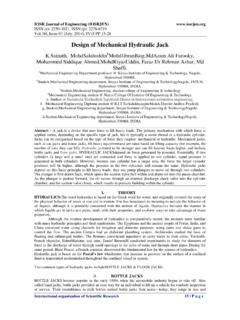Transcription of 12. HEALTH RISKS FROM DRINKING …
1 12. HEALTH RISKS FROM DRINKING . demineralised water . Frantisek Kozisek National Institute of Public HEALTH Czech Republic _____. I. INTRODUCTION. The composition of water varies widely with local geological conditions. Neither groundwater nor surface water has ever been chemically pure H2O, since water contains small amounts of gases, minerals and organic matter of natural origin. The total concentrations of substances dissolved in fresh water considered to be of good quality can be hundreds of mg/L.
2 Thanks to epidemiology and advances in microbiology and chemistry since the 19th century, numerous waterborne disease causative agents have been identified. The knowledge that water may contain some constituents that are undesirable is the point of departure for establishing guidelines and regulations for DRINKING water quality. Maximum acceptable concentrations of inorganic and organic substances and microorganisms have been established internationally and in many countries to assure the safety of DRINKING water .
3 The potential effects of totally unmineralised water had not generally been considered, since this water is not found in nature except possibly for rainwater and naturally formed ice. Although rainwater and ice are not used as community DRINKING water sources in industrialized countries where DRINKING water regulations were developed, they are used by individuals in some locations. In addition, many natural waters are low in many minerals or soft (low in divalent ions), and hard waters are often artificially softened.
4 Awareness of the importance of minerals and other beneficial constituents in DRINKING water has existed for thousands years, being mentioned in the Vedas of ancient India. In the book Rig Veda, the properties of good DRINKING water were described as follows: Sheetham (cold to touch), Sushihi (clean), Sivam (should have nutritive value, requisite minerals and trace elements), Istham (transparent), Vimalam lahu Shadgunam (its acid base balance should be within normal limits) (1). That water may contain desirable substances has received less attention in guidelines and regulations, but an increased awareness of the biological value of water has occurred in the past several decades.
5 Artificially-produced demineralised waters, first distilled water and later also deionized or reverse osmosis-treated water , had been used mainly for industrial, technical and laboratory purposes. These technologies became more extensively applied in DRINKING water treatment in the 1960's as limited DRINKING water sources in some coastal and inland arid areas could not meet the increasing water demands resulting from increasing populations, higher living standards, development of industry, and mass tourism.
6 Demineralisation of water was needed where the primary or the only abundant water source available was highly mineralized brackish water or sea water . DRINKING water supply was also of concern to ocean-going ships, and spaceships as well. Initially, these water treatment methods were not used elsewhere since they were technically exacting and costly. 148. In this chapter, demineralised water is defined as water almost or completely free of dissolved minerals as a result of distillation, deionization, membrane filtration (reverse osmosis or nanofiltration), electrodialysis or other technology.
7 The total dissolved solids (TDS) in such water can vary but TDS could be as low as 1 mg/L. The electrical conductivity is generally less than 2. mS/m and may even be lower (< mS/m). Although the technology had its beginnings in the 1960's, demineralization was not widely used at that time. However, some countries focused on public HEALTH research in this field, mainly the former USSR where desalination was introduced to produce DRINKING water in some Central Asian cities. It was clear from the very beginning that desalinated or demineralised water without further enrichment with some minerals might not be fully appropriate for consumption.
8 There were three reasons for this: demineralised water is highly aggressive and if untreated, its distribution through pipes and storage tanks would not be possible. The aggressive water attacks the water distribution piping and leaches metals and other materials from the pipes and associated plumbing materials. Distilled water has poor taste characteristics. Preliminary evidence was available that some substances present in water could have beneficial effects on human HEALTH as well as adverse effects.
9 For example, experience with artificially fluoridated water showed a decrease in the incidence of tooth caries, and some epidemiological studies in the 1960's reported lower morbidity and mortality from some cardiovascular diseases in areas with hard water . Therefore, researchers focused on two issues: 1.) what are the possible adverse HEALTH effects of demineralised water , and 2.) what are the minimum and the desirable or optimum contents of the relevant substances ( , minerals) in DRINKING water needed to meet both technical and HEALTH considerations.
10 The traditional regulatory approach, which was previously based on limiting the HEALTH RISKS from excessive concentrations of toxic substances in water , now took into account possible adverse effects due to the deficiency of certain constituents. At one of the working meetings for preparation of guidelines for DRINKING water quality, the World HEALTH Organization (WHO) considered the issue of the desired or optimum mineral composition of desalinated DRINKING water by focusing on the possible adverse HEALTH effects of removing some substances that are naturally present in DRINKING water (2).













